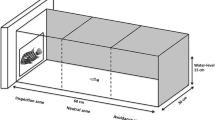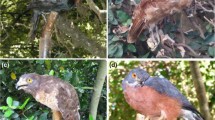Abstract
We exposed naive Siberain polecats (Mustela eversmanni) (aged 2, 3, and 4 months) to a swooping stuffed great horned owl (Buho virginianus) and a stuffed badger (Taxidae taxus) mounted on a remote control toy automobile frame. The first introduction to each was harmless, the second was accompanied by a mild aversive stimulus, the third (1 day after attack) was harmless, and the fourth (30 days after attack) was harmless. Alert behavior increased after a single attack by either predator model. Escape responses of naive polecats did not differ between ages when exposed to the badger, but 4 month old polecats reduced their escape times after a single badger attack. When exposed to the swooping owl, naive 4 month old polecats redponded more quickly than the other two age groups, and 3 and 4 month old polecats reduced escape times after a single owl attack. This indicates an innate escape response to the owl model at 4 months of age, and a short-tert ability to remember a single mild aversive encounter with the badger and owl models at 3 or 4 months of age.
Similar content being viewed by others
References
Alcock, J. 1979. Animal Behavior: An Evolutionary Approach. Sinauer Associates, Sunderland, Massachusetts.
Beck, B.B., D.G. Kleinman, I. Castro, B. Rettburg-Beck, and C. Carvalho. in press. Preparation of the golden lion tamarin for release into the wild. In:A Case Study in Conservation Biology: The Golden Lion Tamarin. Ed. D.G. Kleinman.
Biggins, D.E., M. Schroeder, S. Forrest, and L. Richardson. 1985. Movements and habitat rlationships of radio-tagged black-footed ferrets. In:Black-footed ferret Workshop Proceedings, Laramie, September 18–19, 1984. Eds. S.H. Anderson and D.B. Inkely. Wyoming Game and Fish Dept., Cheyenne, WY. pp. 11.1–11.17.
Biggins, D.E. and R.C. Crete. in press. Black-footed ferret recovery. In:Ninth Great Plains Damage Control Workshop, Ft. Collins CO, April 17–20, 1989.
Biggins, D.E., L.R. Hanebury, B.J. Miller, and R.A. Powell. in press. Release of Siberian polecats on a paririe dog colony.70th Annual Meeting of the American Society of Mammologists, Frontburg MD, June 9–13, 1990.
Clark, T.W. 1987. The black-footed ferret: A progress report.Conservation Biology 1: 8–11.
Clark, T.W. 1989. Conservation Biology of the Black-footed Ferret (Mustela nigripes). Special Scientific Report # 3, Wildlife Preservation Trust International, Jersey U.K.
Clark, T.W., L. Richardson, S.C. Forrest, D.E. Casey, and T.M. Campbell. 1986. Descriptive ethology and activity patterns of black-footed ferrets.Great Basin Naturalist Memoirs 8: 115–134.
Coss, R.G. and D.H. Owings. 1985. Restraints on ground squirrel anti-predator behavior: Adjustment over multiple time scales. In “Issues in the Ecological Study of Learning”. Eds. T.D. Johnston and A.T. Pietrewicz. Lawrence Erlbaum Association. Hillsdale NJ. pp. 167–200.
Eibl-Eibesfeldt, I. 1956. Inborn and acquired in the technique of killing prey (experiments with the polecat,Putorius putorius).Z. Saeugetierkunde, Berlin, 21: 135–137.
Ellis, D.H., S.J. Dobrott, and J.G. Goodwin Jr. 1977. Reintroduction techniques for masked bobwhites. In “Endangered Birds”. Ed. S.A. Temple. Univ. Wisc. Press, Madison WI. pp. 345–354.
Forrest, S.C., T.W. Clark, L. Richardson, D. Biggins, K. Fagerstone, and T.M. Campbell. 1985. Life history characteristics of the genusMustela, with special reference to the black-footed ferret,Mustela nigripes. Black-footed Ferret Workshop Proceedings. Wyoming Game and Fish Department, Cheyenne WY.
Forrest, S.C., D.E. Biggins, L. Richardson, T.W. Clark, T.M. Campbell, K.A. Fagerstone, and E.T. Thorne. 1988. Black-footed ferret (Mustela nigripes) population attributes at Meeteetse, WY 1981–1985.J. Mammal. 69: 261–273.
Gossow, H. 1970. Vergleichende Verhaltenstudien an Marderartigen I. uber Lautausserungen und zum Beuterhalten.Z. Tierpsychol. 27: 405–480.
Henderson, R.P., P.F. Springer, and R. Adrian. 1974. The black-footed ferret in South Dakota.South Dakota Dept. Game, Fish, and Parks Techinical Bulletin No. 4.
Hillman, C.N. 1968. Field observations of black-footed ferrets in South Dakota.Transaction of the North American Wildlife and Natural Resources Conference 33: 433–443.
Hoffman, R.S. and D.L. Pattie. 1968. A guide to Montana mammals. University of Montana. Missoula.
Kleiman, D.G. 1989. Reintroduction of captive mammals for conservation.Bioscience 39: 152–161.
Loughry, W.J. 1988. Population differences in how black-tailed prarie dogs deal with snakes.Behav. Ecol. Socibiology 22: 61–67.
Magurran, A.E. 1989. Acquired recognition of predator odour in the European minnow (Phoxinus phoxinus).Ethology 82: 216–223.
Miller, B.J., S.H. Anderson, M.J. DonCarlos, and E.T. Thorne. 1988. Biology of the endangered black-footed ferret and the role of captive propagation in its conservation.Canadian Journal of Zoology 66: 765–773.
Miller, B.J. and S.H. Anderson. in press. Ethology of the endangered black-footed ferret. In:Advances in Ethology. Paul Parey Scientific Publ. Berlin.
Miller, B., D. Biggins, C. Wemmer, R. Powell, L. Hanebury, D. Horn, and A. Vargas. in review. Development of survival skills in captive-raised Siberian ferrets(Mustela eversmani) I: Locating prey.
Powell, R.A. 1973. A model for raptor predation on weasels.J. Mammal. 54: 259–263.
Richardson, L., T.W. Clark, S.C. Forrest, and T.M. Campbell. 1986. Black-footed ferret recovery: a discussion of some options and considerations.Great Basin Naturalist Memoirs # 8: 169–184.
Richardson, L., T.W. Clark, S.C. Forrest, and T.M. Campbell. 1987. Winter ecology of the black-footed ferret at Meeteetse Wyoming.American Midland Naturalist 117: 225–239.
Seal, U.S., S.H. Anderson, M. Bogan, and E.T. Thorne. 1989. Conservation Biology of the Black-footed Ferret. Yale University Press, New Haven, Conn.
Smith, S.M. 1975. Innate recognition of coral snake pattern by a possible avian predator.Science 187: 759–760.
Stroganov, S.U. 1962. Carnivorous Mammals of Siberia. Academy of Science of the USSR. Siberian Branch. (Israeli Program Scientific Translations). pp. 351–394.
Thorne, E.T. and E.S. Williams. 1988. Disease and endangered species: The black-footed ferret as a recent example.Conservation Biology 2: 66–74.
U.S. Fish and Wildlife Servive. 1988. Black-footed ferret recovery plan. USFWS. Denver, CO.
Wemmer, C. 1985. Black-footed ferret management and research: Views of a zoo biologist. In:Black-footed Ferret Workshop Proceedings, September 18 and 19, 1984, Laramie Wyoming. Eds. S.H. Anderson and D.B. Inkley. Published by Wyoming Game and Fish Department, Cheyenne Wyoming.
Zar, J.H. 1984. Biostatistical Analysis. Prentice-Hall Inc., Englewood Cliffs, NJ.
Author information
Authors and Affiliations
About this article
Cite this article
Miller, B., Biggins, D., Wemmer, C. et al. Development of survival skills in captive-raised Siberian polecats (Mustela eversmanni) II: Predator avoidance. J. Ethol. 8, 95–104 (1990). https://doi.org/10.1007/BF02350280
Received:
Accepted:
Issue Date:
DOI: https://doi.org/10.1007/BF02350280




